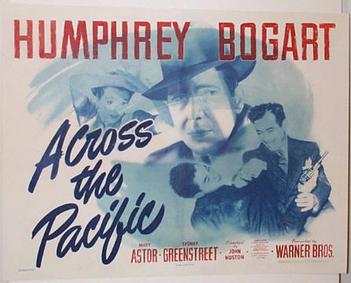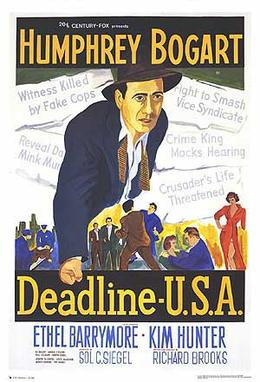Blue Eyes Crying In The
Rain-Watch Your Back, Sister, Watch Your Back-Humphrey Bogart’s “The Enforcer”
(1951)-A Film Review
DVD Review
By Jack Callahan
The Enforcer, starring
Humphrey Bogart, Everett Sloane, 1951
[Although Jack Callahan
very infrequently writes for this publication I feel it is necessary in the now
seemingly obligatory interest of transparency to note that Jack has been a
major financial supporter of this publication both in the days when it was in
hard copy and now on-line. That said it is no accident that Jack is writing
this film review since he along with a cohort, a word by-line writer Seth Garth
has been falling in love with of late and which some of us have picked up on
until some other fall in love expression moves in, of guys like Allan Jackson,
Si Lannon, Sam Lowell, and Phil Larkin who all grew up together in the “Acre”
section of North Adamsville south of Boston and who spent many an ill-spent
Saturday afternoon feasting on such films at the Strand Theater. (This well
before Jack took up with his ever-loving high school sweetheart Chrissie
McNamara, now his wife, at which time they were balcony-bound and I bet
hard-pressed to give detail number one about any film allegedly seen. How they
met and became a high school item is a story in itself which I believe Allan
Jackson has written about in these pages.)
Since Jack is not a regular
writer like those listed above from the Acre a few details are in order-this
beyond the need for transparency but maybe gives the reader an idea of why he
has been a fervent supporter of this publication. Jack, unlike all the others
mentioned and lets’ include the late Peter Paul Markin who has something like
legendary status among this crowd reflected in the inordinate amount of stories
about him in this space and in others, did not serve in the military during the
1960s, during the time of the hellish Vietnam War. Didn’t serve for the simple
reason that he was 4-F which meant physically unable to serve. That disability
the result of a severe football injury sustained when he went to State U on a
football scholarship and got injured in his sophomore year when his team played
Boston College.
Jack, in any case, was not
a natural fit for the crowd he hung around with since he was the high school
football hero as once could imagine. Except he was very shy despite all the
attention every male in the school, and most females, gave him. (He only had
eyes for Chrissie and she for him I really ought to have Allan or Seth revive
that romance story about this pair). These guys provided cover for him since he
was an Acre guy, one of them, one of the poor as sin Catholic boys. Still after
high school and college with one short exception when he went West for a while
with this crew of ex-G.I.s who turned against the war of their generation after
having all the fill they wanted of killing and death Jack was the shoulder to
the wheel guy among the cohort. With Chrissie and later four fine daughters
Jack became Mr. Toyota of Eastern Massachusetts and therefore of all the guys
was the one who made a ton of money. Money which he used partially to help
finance a million Acre boy schemes and this publication. That said lets’ let
Jack go through his paces doing this film review which he begged me, no, asked
me to let him do. Greg Green]
Seth Garth said it best, or
the character in the film Key Largo
ex-World War II officer Frank McCloud played by Humphrey Bogart the lead actor
in the film under review The Enforcer
did, “one more Johnny Rocco, more or less, is not worth dying for.” Meaning in
that case that one Chi town gangster was not worth death when some other Johnny
Rocco was waiting in the wings to move up the food chain. That did stop McCloud
from bang-bang shooting old Rocco when
he messed with his woman and it will not stop ADA Ferguson, Bogie’s role here,
from putting a gangster underground, sending him to the big step off- letting a
few volts do him in. For a while Ferguson was on hard times, looked defeated
against the scumbag was trying to send to the chair but whether there was one
more Mendoza, the arch-criminal here played by Everett Sloane, or not this one
is going down, going down hard.
The reason that Ferguson
was on the ropes for a while in this police procedural, a kind of film noir
that we didn’t necessarily like all that much because in the end the story-line
was always “crime doesn’t pay” and we didn’t like cops very much in the Acre
and had our own reasons for looking kindly on “crime paying” without penalty
which I will leave to the reader’s imagination just in case, was that his key
witness, his only witness against the kingpin was Mendoza’s “dispatcher.” This
stoolie, a guy named Joe, Joe Rico started folding like a hand of cards once
the deal was ready to go down, when he was supposed to go to the witness stand
and finger his boss for a murder when they first started out together. Fearing
the long arm of Mendoza the sappy bleeding all over the place Rico tried to
escape and fell down, fell down hard when he slipped off the ledge of the
building from which he was attempting to flee. Sorry, Fergie, but those are the
breaks when you depend on a rat, a stoolie, a fink, whatever you want to call
such a guy.
But here is where Ferguson
got wise, figured he had nothing to lose by reviewing the case from day one via
a bunch of flashbacks (and then some back flashbacks on those which sounds
menacing to follow but was not, not at all). Wait a minute, maybe I better lay
out Mendoza’s racket first, and why Ferguson was desperate to get him to the
chair. (This “lay out” veteran reviewer Seth’s suggestion). Why Rico would
rather have fallen down than get the big kiss-off from one of Mendoza’s killer
boys. This wily Mendoza must had had some time on his hands and furthermore have
been tired of living on cheap street because he figured out a racket a that a
few guys in the Acre would have loved to have thought of, the perfect crime.
Murder for hire, murder without any apparent motive for the coppers to pin
something on somebody who knew the deceased on. Beautiful in its way. Mendoza puts the word out that he has an
operation to take care of some unwanted person for somebody didn’t matter the
reason or non-reason. Rico, away from Mendoza for plausible deniability
purposes, “dispatches” the “hit” man, pays him off and that is that. Clean
hands, clean as a whistle, perfect crime. Except there was one little misstep
right at the beginning of Mendoza and Rico’s beautiful friendship. The first
murder for hire killing of a restaurant owner ordered up by parties unknown was
witnessed by a guy and his daughter who walked in while Mendoza did his dirty
deed.
That of course meant that
there were two witnesses to what happened and while they were left alone for
whatever reason Mendoza left them alone for that would be Fergie’s edge if he
could find either one. Assuming that he knew there were witnesses which he did once
he dug the dirt up which started him on his long road investigation. The rest
of the story line depends on those flashbacks mentioned above. After going for
years working the murder for hire racket Mendoza stepped into a cab which was being
driven by the guy who saw him murder the restaurant owner. One cabbie gone to cabbie heaven if there is
such a place for the over-charging bastards. Of course if you kill Papa then
you need to waste the daughter since you needed to tidy things up. And that was
done too, or it sure looked like it was done.
The “hit” man on the
daughter job nothing but a stone- cold killer though screwed up, made the
cardinal error of hits. Got to know the young woman and so was ready to back
her out, flee with her. But you don’t do that to a guy like Mendoza and so he
ordered the weak-kneed hit man to kill her under penalty of being killed
himself. That is when things really unraveled. See Mister bad-ass hitman had
moral qualms about killing his girl and went to the coppers who though he was
screwy. Then Ferguson got into the act, especially when that stone-cold killer
committed suicide. Fergusson conducted a thorough investigation (which is how
he got Rico and how he had Mendoza in the slammer ready for the big step-off)
including talking to the slain girl’s roommate after her mutilated body was
found. No help. But Ferguson was intrepid working on every angle and not
quitting, not falling down himself. The pieces start coming together though
once the racket’s aims were exposed when Ferguson was able to ride the train up
to Rico’s part in the whole caper.
You know though that no way
was Mendoza was going to get sprung, although not for lack of trying. Not by
his lawyers but by his gallery of hit men two of who he dispatched to kill that
loose end roommate once he got wise to something. That wise to something is the
beauty of the whole film although we knew what had happened long before
Ferguson and his coppers knew what hit them. See that hit man who killed his
girl, murdered her under duress, killed the wrong girl-she had brown eyes but
eye witness to that restaurant murder Rico who almost spilled his guts out
distinctly remembered the girl’s eyes were blue. Bingo roommate and double
bingo Ferguson who wasted one of the two hit man sent to kill her under jail
cell Mendoza’s orders. Nice, still though thinking back on it I wish every
police procedural didn’t “prove” crime doesn’t pay. Okay that is the Acre in me
speaking.
_film_poster.jpg)

_poster.jpg)


